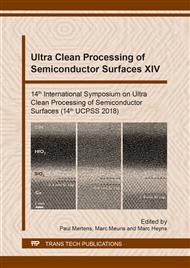p.256
p.263
p.268
p.273
p.278
p.284
p.288
p.295
p.300
Post-CMP Cleaners for Tungsten Advanced Nodes: 10nm and 7nm
Abstract:
Chemical Mechanical Planarization (CMP) is a key process for IC manufacturers. Tungsten (W) is an important material for connecting logic elements and for connecting memory elements, thanks to its excellent planarization, filling, mechanical and electromigration properties. W slurries are developed to remove high amounts of W via an abrasive, in conjunction with an oxidizer. After the polishing process, the planarized surface is contaminated with abrasive particles, organic residue, pad debris and metal cations through covalent or hydrogen-bonding, electrostatic and Van der Waals attractions. Post-CMP cleaning is required to remove all these contaminants while exhibiting low galvanic and chemical corrosion. Formulated cleans are needed to meet all these requirements. The performance of formulated W/TiN post-CMP cleaners for N10 and N7 has been evaluated. The newly developed formulations show a factor 4 reduction in metal surface contamination (from ~2 x 1012 atoms/cm2 to ~ 5 x 1011 atoms/cm2), which is important to prevent dielectric breakdown. Very low particulate and organic residue defectivity was additionally confirmed by different surface characterization techniques: XPS, FTIR, contact angle/surface energy.
Info:
Periodical:
Pages:
278-283
Citation:
Online since:
August 2018
Authors:
Price:
Сopyright:
© 2018 Trans Tech Publications Ltd. All Rights Reserved
Share:
Citation:


